#campaign literature
Explore tagged Tumblr posts
Note
Any good books on losing presidential candidates?
This is an older book but They Also Ran by Irving Stone is a great read about Presidential candidates who came up short.
Almost President: The Men Who Lost the Race But Changed the Nation by Scott Farris [BOOK | KINDLE] is a newer take (2011) on the subject of losing Presidential candidates.
And Michael Lewis -- author of Moneyball and The Big Short, among others -- wrote a frequently overlooked and criminally underrated book called Losers: The Road to Everyplace but the White House [BOOK | KINDLE] that is awesome and genuinely funny. Losers follows the candidates in the campaign for the 1996 Republican Presidential nomination: Senator John McCain of Arizona, Alan Keyes, Steve Forbes, Senator Phil Gramm of Texas, Pat Buchanan, and the eventual nominee, Senator Bob Dole of Kansas. It's forgotten classic of campaign literature.
#History#Presidents#Books#Book Recommendations#Book Suggestions#Presidential Campaigns#Presidential Candidates#Losing Presidential Candidates#They Also Ran#Irving Stone#Almost President: The Men Who Lost the Race But Changed the Nation#Scott Farris#Losers: The Road to Everyplace but the White House#Michael Lewis#1996 Republican Presidential nomination#Bob Dole#Campaign Books#Politics#Political Journalism#Campaign Literature#Also-Rans
23 notes
·
View notes
Text
Political Deception and Funding Tactics in North Carolina Elections
Political Maneuvers in North Carolina’s Mailboxes This week, Republican voters in North Carolina received a striking piece of campaign literature that raised eyebrows and sparked conversations. One side of the mailer featured a sonogram image of a developing fetus, accompanied by a bold message: “Her heart is beating. We all know it. Only the courageous few will protect her.” The reverse side…
#campaign literature#Citizens United#Civic Truth Action#dark money#election tactics#ethical strategies#Kamala Harris#North Carolina#political spending#Randall Terry#super PAC#swing-state voters
0 notes
Text
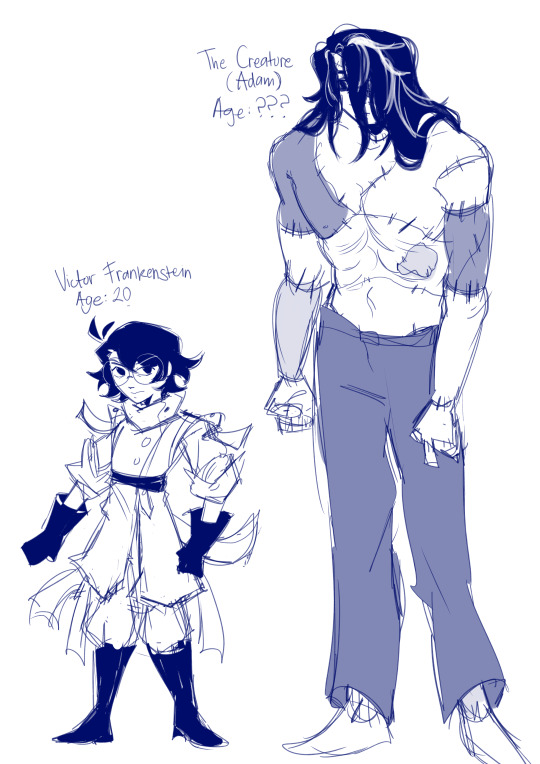

GUYS IM SO ALIVE AND I FR REDESIGNED A BIT OF MY FRANKENSTEIN CHARA DESIGN RAAAAAA
#fanart#original art#gothic literature#the modern prometheus#frankenstein#victor frankenstein#adam frankenstein#the creature#mary shelly's frankenstein#tbh i was redesigning them cuz i wanted to put them as a cameo in my dnd campaign#though tbh if i wanted this to be canon in my headcanon it works too#cuz honestly seeing victor with actual like scientist lab outfit is refreshing in my eyes#though other designs will not change#probably the change is minor but eh my art style is having a metamorphosis era rn
336 notes
·
View notes
Text
Critical Role's Previous Cameraman
I put up a post the other day about critical role's new animated introduction and I couldn't help but notice a sudden spike in the analytical stuff that I don't really understand. A more tech orientated friend of mine informed me that this was a good thing, actually. So, I thought I might capitalise on that and examine the previous campaign's opening sequence through the same lens and do some more analysis.
Let me explain.
SPOILERS AHEAD

One notable thing about this song is when it starts. Exactly eleven seconds in. That's eleven seconds of wait before the final payoff. You catch glimpses of what's happening above, but nothing else.
And that is a key theme of this campaign. The unseen. The Mighty Nein was a party characterised by trauma, and a lot of the time, you don't see that, you only see glimpses. A flash of a fight they told you about, and the sensation of drowning.
But then we meet Fjord.
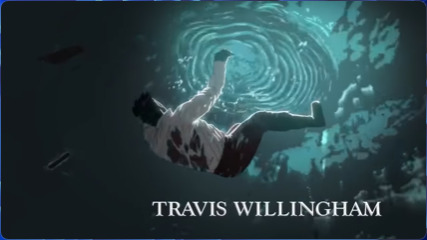
He's falling, and I'd like to point out the direction in which he is falling. You will notice the scars on his back, signifying he was probably in the process of running away, or was betrayed by someone, and he is falling towards those scars. Backwards. There is also a neat thing of falling away from the light, into the darkness, into the unknown. THis is someone out of control, leaning into the pain. And what is it that sees that?
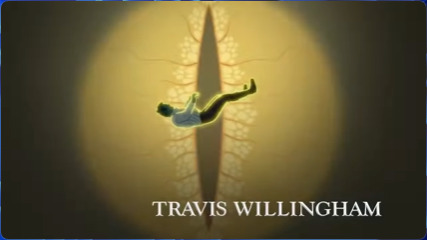
There is a reason Uk'otoa's design looks so much like a leach. The creature is a parasite, it doesn't find someone strong to break down, it found someone weak, and at its mercy, and brought him under its control. What this shot does is highlight that creature's opportunistic nature, but it also associates it very clearly with the visual of that eye.

And it's that eye that carries through. When Fjord washes up on the beach, when he is finally safe, he carries with him a little piece of Uk'otoa, a little piece of that trauma.
It's also notable of that it is an eye. It's obvious, but it colours his vision, and changes how he views the world. Its effects aren't physical, but mental.
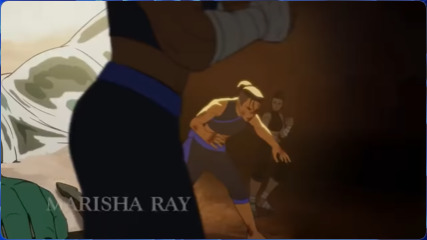
Beaureguard Lionet is a fighter. Not in the sense of class, because she isn't but in the sense of personality. Beau is a fighter in the sense that her first reaction to any problem is to punch it.
This transition is a wipe transition, but its important because of what it uses. It uses the opportunity to show off the uniforms of Beau's attackers, because otherwise the shadows of the rest of the shot make them hard to make out. These are wearing the same robes as her. Whoever they are, they are part of a team of some kind with her, they are people she should be able to trust, but look at how much damage they have done to her. Look at how heavily she is breathing. And look at what Beau does in response.

She fights back. This is how the animation gets across this character. She isn't complex, she doesn't need a great explanation, she doesn't have different sides to her, she just hits things until they stop being a problem.
I will also point out her eyes again. They are blue, not an unnatural eye colour, but they are the same blue as her robes, and the robes of those who are attacking her. Once again, the has warped the vision of its recipient, and in this case, it's creating a cycle of violence as all she knows how to do, is hit things.

We don't see Nott The Brave for a while in this animatic. We instead see, once again, the eyes. But I also want to point out that this was made before we knew about Veth. So we were just seeing the scared goblin.

This is as close as we get in this scene, and its Nott actively hiding from the light. The warmth scares her, and for good reason, its the same heat that we see emanating from her eyes. Once again, the trauma that has contaminated a character's vision is changing their reactions to the world.
And with that, I would like to talk about Jester, and I would like to do that in context.

The term "foil" in the context of a character was actually popularised by William Shakespear, who handily explained the metaphor for us.
"And like bright metal on a sullen ground, My reformation, glitt'ring o'er my fault, Shall show more goodly and attract more eyes Than that which hath no foil to set it off."
Put in English, I shine brighter when you have something to compare me to. And this is what a foil character is, a character who brings about elements in other characters that can easily be missed, or who shows off by contrast their personalities.
Jester is one of the two characters in the Mighty Nein who is not a child of trauma, and her introduction shows that. She reacts to her life by laughing, and contrast that with everyone else. Fjord reaches for a sword, the item of his trauma; Beau tries to fight her trauma despite that approach clearly not working; and Nott hides from it, unable to reach out for help.
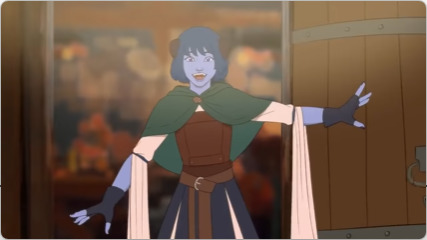
And it is notable that the first time we see an adult Jester, she looks normal (if a bit over cheerful), then is immediately contrasted with the rest of the Nein.
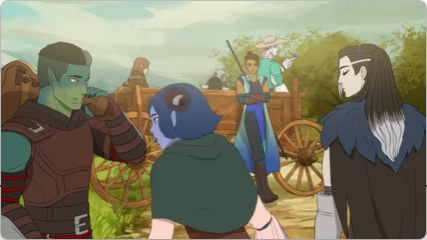
This not only shows just how different her demeanour is from the rest of the crew, but it shows her effect on them. She makes them all smile. Jester and Caduceus are very much support characters in the truest sense of the word. They support others. Jester shows genuine kindness towards everybody else, and it reflects onto them.

This shot is neat but not too special. Its a tracking shot on the hat of all things, because thats what important here, and it shows the traveling dynamic of the group. It's a tiny bit of tension in an otherwise calm scene, so the camera is steady, but speeds up slightly to match the movement of the object, then comes to a stop when it is caught. There is very little stress, but there is a sense of comradery.

Similarly, this shot establishes some stakes with a rising pan to show the scale of the threat and to show some more information, but it is hardly a monster, so the camera isn't really in a hurry.


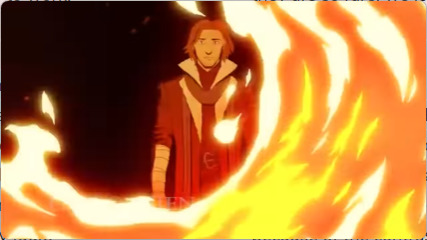
Enter Caleb Widogast, born in fire. I don't think they could write a more thematic entrance if they tried. An abrupt cut shows the night, then it is entirely consumed by fire, only to reveal Caleb.
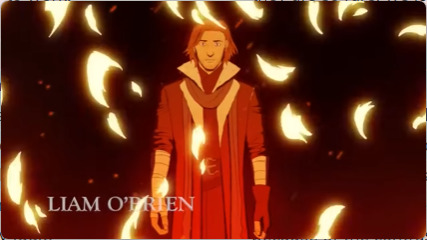
There is no motion here. The camera is stock still. This is the exact same thing with Ashton and FCG in the Bell's Hells. Caleb is disassociating from the heat in front of him, and there is a fascinating reason behind that. Caleb has two characters that need to be introduced to better understand him, the man, and Bren, the boy.
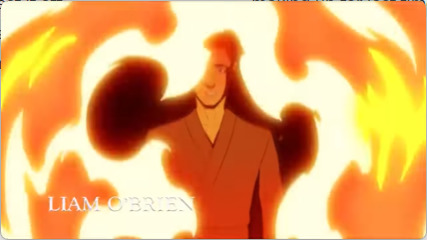
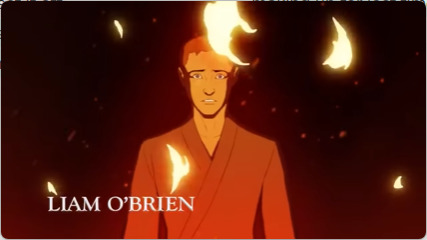
The flames consume the screen again, and then part to show a boy, staring at the screen, in horror. This is what you need to know about this character, this is a character forged in flames, born from the Ashes. Bren is dead, Caleb Widogast remains.

And this shot, with Caleb, Astrid and Eadwulf silhouetted against the fire, shows what kind of trauma we are talking about, and what effect it has. This is guilt, and in contrast with the rest of his party, this guilt is paralysing.

Yasha, however, is introduced in a calm way, in contrast to everything around her. The camera shows you a woman, meditating, and then pans backwards to reveal this:
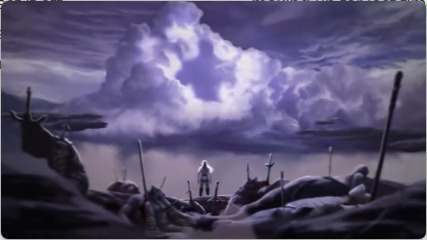
This is a woman surrounded by bloodshed, who has made a concerted effort to look away from it, and to look to the Storm Lord for guidance. This is a woman looking for healing, in comparison to everyone else, but that looking doesn't change the fact that that trauma is still there.
The next few scenes are cool, but don't really add anything to this analysis and I only have a few more images I can show here, so I'm going to skip to Taliesin's characters.
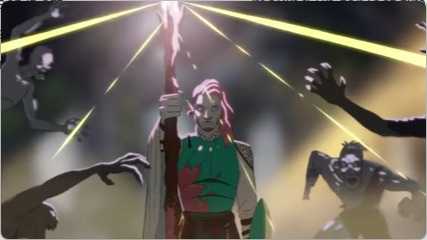
Caduceus has two introductions. One is this shot, which is a cool action shot of him casting an epic spell and vanquishing a crowd of enemies. But instead of the incredibly animated (in the sense of exaggerated poses) nature of his companions, Caduceus clay is calm and collected. He is unquestionably the anchor of the group, and where Jester contrasts them emotionally, Caduceus does so on a philosophical level. Caduceus is a gardener of fungus.

Mushrooms and other fungi are recyclers, they grow on dead trees and creatures and give a forest new life. They clear out the debris and make way for new things to take hold. That's what Caduceus does for the Nein, he helps them get through their trauma so that Jester can help them improve and become better.
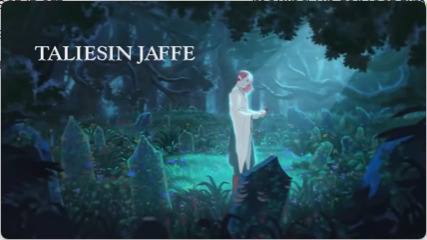
Caduceus's actual introduction is muted, and there's a point to that. He's not trying to be the main character, you don't need to understand his family life to understand him. You need to understand that can stand in a graveyard and see the light, that he is at peace with what has gone before him and helps people to get past it, and that his entire mission, to regrow the grove, isn't to bring back what is lost, but to help regrow something new in its place instead of the blight that lingers there.
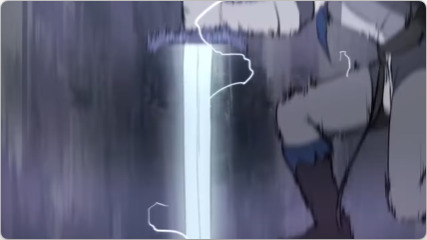
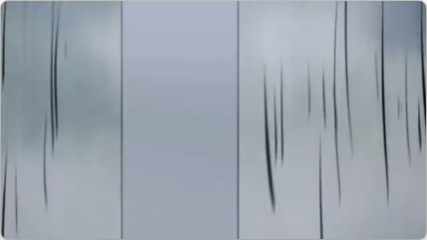
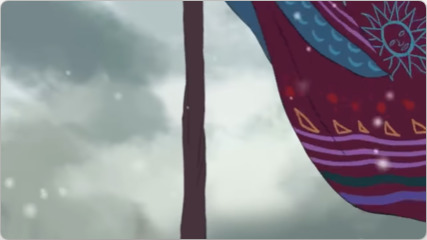
Mollymauk is introduced as a weapon transformed into a grave. That is what this transition is and I think that's really important. Mollymauk is, very clearly, a repurposed soul. He isn't the first person to inhabit that shell, and he isn't the last. I also want to point out how this character is represented here, not with a heroic memory, but with a quiet moment or remenicing on times gone by. He is a shadow that haunts the Nein.

This is by far the simplest shot in the entire video, and that's because it isn't telling you anything. You bring your own emotions to the table here, you bring the memories to the grave, that's how grieving works.
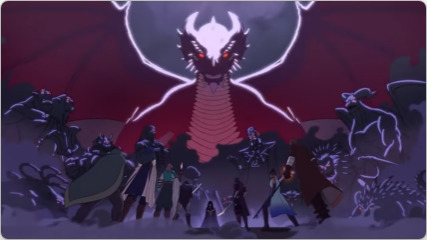
Once again, there is more to this video, but I'm only allowed to put 30 images in a single post. So I leave you with a quote from Niel Gaiman.
"Fairy tales are more than true: not because they tell us that dragons exist, but because they tell us that dragons can be beaten."
DnD likewise, and all TTRPGs for that matter, are powerful because in them, with a little bit of help from friends, any monster, no matter how personal, can be defeated.
#rants#literary analysis#character analysis#literature analysis#what's so special about...?#critical role#critical role campaign 2#the mighty nein#mighty nein#caduceus clay#cr caduceus#fjord stone#fjord cr#beauregard lionett#cr beauregard#nott the brave#cr nott the brave#veth brenatto#veth the brave#mollymauk#yasha#caduceus#beauregard#nott#jester lavorre#beau#jester critical role#caleb widogast#caleb critical role#yasha nydoorin
185 notes
·
View notes
Text
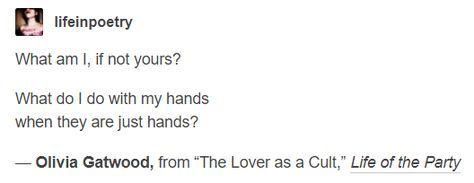


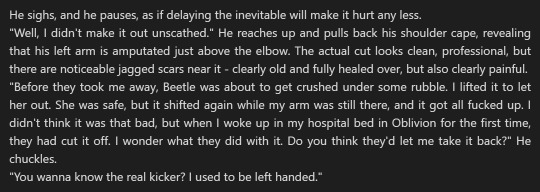





something about hands and love (a web weaving about a dnd npc)
#web weaving#web weave#webweaving#on love#on grief#on emotion#bittersweet#literature#lit#quotes#poetry#lyrics#dnd#dnd oc#olivia gatwood#mitski#sylvia plath#the crane wives#oblivion campaign spoilers
281 notes
·
View notes
Text
rereading the idiot for my idiot-based d&d campaign has made me realize and get excited over how fucking batshit it is all over again. like what the fuck. i could write a whole essay about nastasya and how Doomed By The Narrative she is. this is why dostoevsky can bear my children
#the idiot#the idiot dostoevsky#fyodor dostoevsky#ruslit#russian lit#russian classics#classic literature#classic lit#going insane#it’s the party in part 1 man#like when they’re like ROGOZHINS HERE!!!!! i started getting so excited i was like shits about to go DOWNNNN#and just nastasya’s energy too#maybe im too empathetic for my own good#who knows! (suffering because i can’t tell my internet friends about it) (they’re in the campaign itself)
13 notes
·
View notes
Quote
There are people that are to champion the campaign and advocacy against the cycle of ungodliness and injustice in every nation.
Sunday Adelaja, The Mountain of Ignorance
#Sunday Adelaja#The Mountain of Ignorance#quotelr#quotes#literature#lit#advocacy#campaign#champion#danger#darkness#destruction#god#ignorance#injustice#knowledge#life#light#mountain#nation#people#power#ungodliness
8 notes
·
View notes
Text
Phoenix: This problem isn’t just going to go away.
Achilles: No. But maybe you will.
#s: house#campaign to achilles tent 😌 all jokes ofc achilles loves phoenix all his homies love phoenix#greek mythology#greek myth#achilles#phoenix#ancient greece#mythology#mythos#incorrect greek mythology#greek mythos#incorrect quote#trojan war#iliad#homer#classics#classics memes#literature#literature memes#tagamemnon#greek myth meme#greek myth memes#myth#greek mythology memes#greek mythology meme#incorrect greek quotes#incorrect greek myth#incorrect quotes#the iliad#patroclus
61 notes
·
View notes
Text
The Teviri
(Art by Lorena Carricondo)

The Teviri are humanoid creatures with elongated bottom canines and rough ram-like horns with a metallic substance inside which tend curl just around their long bovine-like ears. They seem to have a strong understanding of natural and magical magnetic fields.
The traditional Teviri culture comes from the plains area of Sa’Oloto where they live in a nomadic culture using their innate sense of electricity to guide livestock herds following the path of rain. Their culture has a great reverence for lightning as their attention is heavily drawn to areas about to be struck. The closest country to them is Aeloria who technically considers the Teviri homelands to be within their country but have made multiple deals with Tevirin leaders to allow for the continued usage of the “Tevirin Plains” in Sa’Oloto.
Though their culture originates in the Tevirin Plains, many Teviri live throughout the world from Vihark to Ascain. Their unique abilities regarding magnetic fields and generally more sturdy build allow them to thrive in more conventional cities or even adventuring.
This has been a short introduction to the Teviri.
#dnd#ttrpg#fantasy#fiction#literature#teviri#homebrew#dnd5e#dnd homebrew#Stormbound#dnd podcast#dnd campaign#dnd lore
8 notes
·
View notes
Text


Today was tsundere day and so here is my oc dressed as natsuki
#art#digital art#digital drawing#drawing#artists on tumblr#dnd#dnd art#dnd campaign#dnd character#small artist#cringe#cringetober 2024#cringe culture is dead#cringetober#doki doki literature club#doki doki natsuki#tsundere
3 notes
·
View notes
Text
What Is It About Dinner Parties?
Spoilers for:
Rocky Horror Picture Show
Shrek 2
A Civil Campaign (Vorkosigan Saga book 13)
The Nightmare Stacks (Laundry Files book 7)
I recommend every one of these works, with the caveat that you should really get into their respective series where applicable for the best results. Spoilers will not completely ruin the experience, but if you have the patience and opportunity to watch three movies and read several thousand pages, go do that first. (After is acceptable if you prefer.) When obtaining books remember to first check at a library or local bookstore. Do not buy from Amazon if you can avoid it. Audible is Amazon.
Content advisories: Works discussed here include depictions of sexual assault, murder, cannibalism, adultery, and various anti-LGBTQ+ phobias. (Rocky Horror is the main offender but some of the others contribute.) Additionally this explores awkward social situations in great detail, so you may want to skip if that sort of thing lives in your head.
I have noticed that fictional works often use scenes at dinner parties as key turning points in their stories. This is achieved through a combination of rising tension, humor, and tying together many plot threads at once. It's possible to do something similar without the humor (eg. the Hitchcockian suspense of a bomb under the table) but that's not what I'm looking at today.
A note on definition: when I say “dinner party” here, I mean a social event in which a group of people who do not share a household meet for the main purpose of sharing a meal. This is different from a regular party, gala, ball etc. where activities other than the meal are the focus.
In my observation, the anatomy of a dinner party is as follows:
Stage Zero: Setup
A key element will be the interactions between characters who would prefer not to deal with each other. There are a few ways to build the guest list to achieve this. You can have the simple case of someone bringing a plus one without warning in advance who (or what kind of person) they would be. It's also possible that invitations were sent before a conflict came up, or the host may be unaware of the issue. There may also be a broader social obligation on attendees, such as a holiday. Wholly uninvited guests usually don't happen in this sort of scene (those are more characteristic of less intimate social events, like a charity ball turned hostage situation).
Rocky Horror's dinner party takes place right after several less than fully consensual sexual encounters and a very bloody murder, with the characters being assembled through social force and implied threat of violence. Shrek 2 has it as the first sustained interaction between the title character and his royal in-laws after his elopement with Princess Fiona. A Civil Campaign spends about half the book just building up to this event, with protagonist Miles so focused on making it a success for his main goal that he loses control of the guest list, the menu, and even the staff. In The Nightmare Stacks, it's a family meal introducing two prospective (and unconventional) significant others to the parents at the same time.
Stage One: Civility
The scene begins with all parties acting superficially civilly. The threads of the narrative and the stressor are both on the back burner as action begins. There will be hints of the conflicts to come, especially as the principal characters become aware of the full guest list and its implications. This phase may be very brief, or even skipped if the story uses immediately previous scenes to establish sufficient tension.
The Rocky Horror party's first minute strains the definition of "civility", with awkward silence accompanying deliberately sloppy table service. Shrek 2 likewise uses silence to delay interaction as long as possible. A Civil Campaign has a very large cast to introduce, but the atmosphere is casual with just a hint of stress as Miles does his best to manage the bloated guest list. The Nightmare Stacks barely gets everyone in the door before the incompatibility of hosts and guests becomes apparent.
Stage Two: Interaction
This generally starts with the appearance of food and of necessity seating of guests. This is the point where the characters in conflict are first forced to interact rather than passively stay away from each other. It's possible for this stage to still be indirect, but proximity means that there's no way to sustain the illusion of civility.
In Rocky Horror they can't even finish singing "Happy Birthday" before things start to escalate. Shrek 2's initial interactions are wordless, using the series' signature facial expressions to show to what degree everyone is already hostile or unaware. A Civil Campaign has Miles realize his carefully arranged seating positions have been disturbed by someone with different priorities, but most of the social tension is surprise rather than hostility. The Nightmare Stacks stumbles past this step right into the next when it turns out the guests have mutually exclusive dietary preferences.
Stage Three: Conflict
Next, some minor issue arises, like one character breaking a social convention. There is almost universally some issue with the food itself as well. Depending on the number of characters and plot of the story, this can go on for some time. This is often where most of the comedy of the scene comes in. Events may become more and more absurd, allowing things to escalate without over-burdening the reader with stress. Often the issue isn't even directly related to the core conflict of the story, or starts with a lower-stakes side plot. In doing so, it can weave such plots into the main one.
Rocky Horror is already under so much stress that it takes just the smallest spark to get things burning. Shrek 2 likewise gets here quick, as Shrek's cluelessness with regard to etiquette kicks off an escalating series of indirect and then direct criticisms. In A Civil Campaign the awkward seating arrangement makes social interaction difficult, and Miles realizes that the menu has been undermined in a way that could cause an uproar and deeply offend some very senior guests. The Nightmare Stacks lays on the dramatic irony, where a conservative father is too busy learning about gender nonconformity to worry whether his son is actually dating an Unseelie Fae princess (the answer is "unclear", but only about the "dating" part).
Stage Four: Eruption
The issue that led to the tension established before the scene is exposed to all present. More often than not this is caused by something in the comedic action accidentally exposing concealed information or causing a stressful event to be discussed or even repeated. Sometimes the comedy itself is the issue, with the disruption alone being enough to expose the issue eg. if it’s due to contrasting social norms. Regardless, this is the climax of the scene where everything comes to a head at once.
Shrek 2 kicks into high gear, with characters becoming so incoherent they can only scream out each other's names. Rocky Horror and A Civil Campaign reveal the truth about the meal they've been eating. The lack of coordination in A Civil Campaign causes Miles to move forward his social plans to disastrous effect. The Nightmare Stacks has the meal collapse into such disarray that the protagonists are able to escape unscathed.
Stage Five: Tone Shift
The comedy is (usually) suspended and drama kicks in. This is often also a turning point in the larger story. It may mark an act transition (typically second to third) or just a change in the intensity of the conflict. In a romantic comedy, this is a prime opportunity to get into the things-just-got-serious phase where the core relationship is under threat.
Rocky Horror's dinner party serves to launch the climax by getting everyone in place for the final showdown. In Shrek 2, where it's the act two kickoff, it establishes the stakes that Shrek can't simply slide into place as a socially acceptable fiancé for Fiona. In both A Civil Campaign and The Nightmare Stacks, the result of the dinner party is the revelation of the true intentions of a main character, respectively openly courting another (it's complicated) and tricking her counterpart into meeting her parents (it's complicated). They both leave the protagonists with few paths open to them and even fewer good ones.
Why do they work like this?
I think the main thing that makes the dinner party so effective at progressing a story in both plot and tone is the contrast between natural and unnatural human interaction. Sharing food is one of the most basic interpersonal activities, with archeological evidence going back further than anatomically modern humans. This is in tension with the artificiality of the actual situation, where precise details of food presentation, respect for social norms, and personal behavior are under scrutiny from individuals you may not fully trust. Food in general also has a visceral impact on everyone. No one is sophisticated enough to willingly eat all of "Meatloaf", escargot, "bug butter", and vegan "pizza", so you as the consumer of the work are forced into empathy with the characters.
Given a scene where everyone is under stress by default, you add on the wider context of the story. Any plot where progress is blocked by "well what if everyone who isn't getting along just avoids each other" is immediately reinvigorated. It's often the case that not everyone is aware of other moving parts, so things can move forward by broadening the impact of ongoing issues to the rest of the cast. If it's too early in the story for things to really blow up, the dinner party can still raise the stakes or expose fault lines that were previously unseen.
If you accept either of the theories that humor is built on tension and unexpected relief or on juxtapositions between the familiar and the incongruous, the natural/artificial split in the dinner party setup also provides these. Everyone on both sides of the fourth wall expects a certain degree of decorum, but it soon goes out the window and leaves you and the characters equally off balance. Likewise, the sharing of food presupposes that everyone can actually partake in the food presented, and undercutting that is a further violation of the common vision of what a dinner party should be. The way characters react to that challenge is another easy hook for comedy.
Conclusion
Putting it all together, dinner parties really do it all. Tension and release, humor and drama, heightening and resolution - the dinner party has the tools you need. Next time you read or watch a dinner party scene, think about the role it plays in the story and the way it's constructed to fulfill it. They're some of my favorite scenes, and I bet they could be some of yours too.
Detailed Examples
Originally I planned to give each spoiler-warned work a stage-by-stage breakdown, but they needed so much context that tumblr's editor broke. Instead I will give them dedicated posts and update this one as I go.
#tropes#shrek#shrek 2#rocky horror picture show#the laundry files#the nightmare stacks#charles stross#vorkosigan saga#a civil campaign#lois mcmaster bujold#writing#dinner party#long post#literature#original post
23 notes
·
View notes
Text

Markarian Spring/Summer 2020 Ready-to-Wear Collection
#markarian#fashion#ready to wear#fashion collection#fashion campaign#ad campaign#spring summer 2020#s/s 2020#summer aesthetic#classic academia#classic aesthetic#literature aesthetics#my gallery
10 notes
·
View notes
Text

OMG two posts in one day?? What are the odds? Anywho this is a sort of OC storyline set within Alfarwind, my homebrew/original D&D setting which is epic high fantasy, mostly the bland Western type with a couple, highly, notable exceptions. For this (monthly?) LitRPG series is going to be set in the southern coasts of the continent of Dulgren, specifically in the Kingdom of Galadinor which was one of the first Princedoms to rebel against the Empire of Concordia. Now, 138 years later, many in Galadinor live in hardship against the rule of a thick bureaucracy which is corrupted by much darker forces; and whilst the bureaucrats argue the lands of Galadinor are ruled by bandits and rebellious barons.
However, this is no tale of lords or of princes or even of kings, for we fall in line to the adventurers of Galadinor, aka the lowest of the lows, and the King of those paupers? Why of course it has to be, without a doubt...
The Grape-Smashers.
Follow the adventures of Det. Alastair Netherwaste (Lvl 3 Celestial Warlock), Travelle of Bregoncourt (Lvl 3 Ghostslayer Blood-Hunter), Lidryn Firetongue (Lvl 3 Draconic Sorcerer), and Godzimir of the Halny Mountains (Lvl 2 Oathbreaker Paladin, and Lvl 1 Barbarian). Classes probably won't be super important but I thought it would be fun for y'all to have! (*wink*)
I won't go super in-depth because I want to leave secrets but Alastair (He/Him) is an ex-convict before his run in with the paladin Ser Kithola Luelrift (She/Her), whom forced his repentance. Alastair is now a lowly-paid detective who travels alongside his cohorts. Alastair is Bi.
Travelle of Bregoncourt (She/Her) was a travelling street performer and the daughter of a famed mystic before her and her family's caravan were attacked. Ever since then Travelle has had a knack for not only seeing ghosts, but hunting them as well. Travelle is Straight and Trans.
Lidryn Firetongue (He/They) unknown. Assumedly a prince of some sort due to his ancestry of magic. Lidryn is a Demimale.
Godzimir of the Halny Mountains (He/Him) born in the Halny Mountain range within the Kingdom of Ardrezenskia (or Ardrezenium in the west), Godzimir is a part of the highland Rumiany tribe before they were decimated at the Battle of Godor's Keep. Godzimir was then raised by an evil cult known as the "The Eye of the Sparing," however, he has since moved on from then... we think. Godzimir is Pan.
Anywho I hope you guys enjoy and stay pumped because the first little text will come soon! This should be like a monthly thing so hopefully I can pump out something epic for everyone to enjoy!
Also for attribution {the squiggly borders} Image by Freepik, the rest is by me.
#writing#original story#worldbuilding#fantasy#dungeons and dragons#d&d#d&d teaser for my campaign#writer things#writers on tumblr#story in progress#story#stories#fiction#literature#literate rp#litrpg#fantasy fiction#high fantasy#sword and sorcery#trans character#image#grapes#original character#original art#original post#original content#kinda long post#kinda like that#dungeons and dungeons#a labor of love
2 notes
·
View notes
Text



ms paint shenanigan BUT MY GOD I CANNOT BELIEVE IM DRAWING THEM AGAIN AAAAAA
#fanart#gothic literature#frankenstein#the modern prometheus#victor frankenstein#the creature#adam frankenstein#my apology for drawing in ms paint BUT GOD FINALLY I PUT FRANKENSTEIN AS A CAMEO IN MY DND CAMPAIGN HIHIHI#GOD THE RELIEF I FELT REVEALING ABOUT HIM TO MY PLAYERS IS INSANE#cant wait for my players in my campaign to confront him hehehehehhe
112 notes
·
View notes
Text
In the quiet corners of her mind,
A battle rages, hard to find.
She wishes to love, to feel the spark,
But shadows linger, leaving her in the dark.
Her heart is heavy, burdened with pain,
Longing for love, but bound by a chain.
She gazes at the world with weary eyes,
Hiding her tears, masking her cries.
She wants to love, to let it flow,
But the fear inside won't let it show.
Not even herself can she embrace,
Lost in a maze, seeking a trace.
May she discover the strength within,
To heal her heart, let love begin.
A girl so brave, with a soul so deep,
4 notes
·
View notes
Text



A History Of Violence: Ethnic Group Identity And The Iraqi Kurds by Craig Douglas Albert
#Iraq#saddam hussein#kurdistan#West Asia#I have a few issues with the rest of the article but these beginning bits were great!#He added that Kurdish is not a unified tongue and I agree with that to *some* extent...#I just have a few problems with his description on Kurds but also one problem with him not calling Al-Anfal genocide?#It was a genocide.#It was Ethnic cleansing.#It was way more than military campaigns. Come on now.#And this is also why I say having the Shah was not a good time in Iran for Kurds.#Shah didn't help the Kurds. He let Saddam oppress them.#Racism#Pan arabism#arab colonialism#Literature#nonfiction#Longreads#Essays#journal article
4 notes
·
View notes